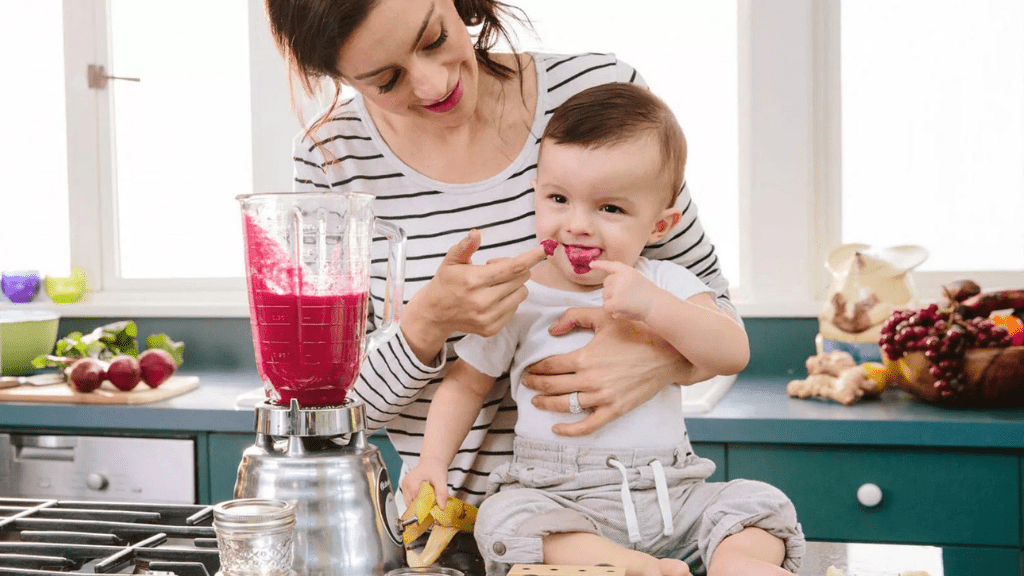
Table of Contents
Are your baby’s changing food habits and appetite making you look out for different super healthy and cost-saving options? Try making your own baby food and save your time scouring for options!
By the time of your little one’s half-birthday, they will be ready to experience their first spoonful of solid food. There are different ways of introducing your munchkin to solid foods. Some parents try baby-led weaning which involves introducing solid foods in the form of soft and gummable finger foods after your baby is over 6 months old. By this age mark, babies typically tend to get comfortable with self-feeding.
Parents may also start solid foods by spoon-feeding pureed fruits or mashed veggies, fruits, proteins, and grains. Purees are easy to swallow so they can be introduced a bit sooner, again, typically between the ages of 4 and 6 months. This age bar also depends on the advice of your baby’s pediatrician.
If you are going to start with purees, you can easily purchase commercially made baby food or make your own at home from scratch. Both options are nutritious, but for parents who are wondering how to make baby food so that they have total control over what their baby is eating, we have curated every piece of information to make sure your decision is right.
What Supplies Do I Need to Make Baby Food?
If you are preferring purees as your form of introducing your baby to solid foods, then you will need something to puree or grind your baby’s food to get the right consistency. You may use an immersion blender, food processor, or a blender; the equipment you may already have in your house! Or if you want, you can get a bit fancy and get gadgets made specifically for making baby food.
Options you have are
- An all-in-one baby food maker that can both steam, cook, as well as puree the food.
- A strainer or sieve
- A baby-food grinder
- A hand-turned food mill with different kinds of blades for different types of textured food.
Or you could save some money and go low-tech with just a potato masher, fork, or even a spoon. This will work well if you are preparing mashable foods like butternut squash, bananas, or avocados.
How to Make Baby Food: Points to Remember
Learning to make your own baby food is way easier than you think. Follow these few steps to get going:
1. Clean Your Workstation
Before you clean your workstation, make sure you clean your hands too with water and soap before you start making food for your baby. If you touch eggs, fish, or raw meat make sure you wash your hands as these foods may be harboring bacteria, and then make sure all your work surfaces and utensils are spic and span. If you are sampling the baby food while you make it, make use of a fresh spoon and wash it off each time you use it.
2. Prepare The Ingredients
Grains and Cereals
Always make sure to check the package instructions before you cook. The best options for you to choose from are whole-grain barley, whole-grain oats, iron-enriched grains, and single-grain varieties. You can either grind or puree them. When you introduce your baby to grains and cereal, serve them with formula or breast milk to thin out the food’s consistency.
Fruits and Vegetables
Boil, steam, or bake hard fruits and vegetables, like carrots, before grinding or pureeing them. Orange or mild yellow veggies like carrots and sweet potatoes; green veggies like string beans and peas; and fruits like pears, peaches, and bananas all work well.
You can either choose to peel, strain, or pit as needed, and then puree them in a blender, food mill, or grinder, by adding any liquid of your choice like formula, breast milk, or water to get the proper consistency. As your baby gets older and becomes more of a confident eater, you can serve them chunks of solid foods.
Meats and Poultry
Puree skinned and trimmed cooked poultry and meats either with already introduced food or alone. You could use foods like vegetables to create all-in-one meals or minced meats like beef, turkey, lamb, or chicken.
Add Healthy Flavor
It will be a good choice to start with unseasoned foods as the baby’s taste buds are developing, and he has not yet developed a craving for salty or sweet foods. So, when you give him food straight up, he will be more likely to develop the taste for those foods.
If you want to add some extra pizzazz to carrots, sweet potatoes, and other vegetables then stick to herbs that are healthy like cinnamon. Or you can also sweeten the bowl with mixed pureed fruits such as pears or apples.
3. Safely Feed and Serve
Finally, before you feed your baby, remember to wash your hands with water and soap and make sure the food is at room temperature only for about an hour, as cold food must stay cold and warm foods must stay warm. If you are in doubt about the food’s freshness, throw it out.
At last, when your baby is eating foods with multiple ingredients, as she graduates from purees to finger foods, you must be certain that the ingredients like dairy and cheese products are completely pasteurized. If these foods are served raw, they could lead to infections from the bacteria present in them. Undercooked or raw food are breeding grounds for salmonella, so to be on the safe side use pasteurized eggs also.
How to Store Homemade Baby Food
You may store homemade baby foods in the fridge for a day or two or in the freezer for about two months. We wouldn’t recommend feeding your baby foods preserved for months as freshness is always our top priority. You can spoon these homemade purees into ice cube trays or single-serving containers for easy-to-serve portions.
Warm the leftovers on the stove and then feed them to your child. Keep it on the stove, stir it, and let it stand for 30 seconds. Before serving it to your child, test the temperature; purees should always be lukewarm and not hot.
How to Make Baby Food: Tips You May Follow
Let’s check out all you need to keep in mind when making baby food
- Cook down the vegetables and fruits in a slow cooker, steamer, or pan, then blend the mixture or mash it up until you get a smooth consistency.
- If you want to thin the consistency of the puree, you may mix it with a bit of formula, breast milk, or water.
- It’s completely okay if you find some lumps in the puree as long as you can mash it with your fingers before serving it to your kid.
As your little one gets older and is confident about different kinds of solid foods, you may gradually start serving her foods from the menu of the rest of the family but puree it, blend it, or mash it up to the right consistency.
The Bottom Line on How to Make Baby Food
Apart from those tips above, make sure your baby eats under your supervision especially when he is just a beginner at eating solids, to keep your kid from choking on the food or preventing similar mishaps. Also, you can always make purees with your child’s favorite fruits or veggies.
How to Make Baby Food: Tips, Ingredients, and Storage of Baby Food FAQs
1. How to make baby food?
2. Is it cheaper to make your own baby food?
3. What liquid can you use to make baby food?
4. How long is homemade baby food good for?
5. What kind of purees can a 4-month-old eat?
Sources:
Reviewed By:

Jessica - Nutritionist Dietician
Jessica is the owner and registered dietitian nutritionist at Nutrition That Heals, LLC. She started her dietetics career working in acute care where she gained a great deal of invaluable experience, learning all about different disease states and their appropriate nutrition interventions. She then worked in long term care where she was able to develop her skills and knowledge base dealing with the elderly population. Following long term care, she worked as an outpatient dialysis dietitian, working with patients to help them eat their best for their kidney failure and often other health conditions (diabetes, heart disease, etc.). She then made the jump back to be an inpatient clinical dietitian. There, she was able to work with patients with strokes, cancer, orthopedic issues, as well as the pediatric population. During her most recent time working as an inpatient clinical dietitian, a great opportunity presented itself and it was a great way to move into focusing more on her dream of opening a private practice. She currently works full time as a contract dietitian with Dietitians on Demand conducting 1:1 nutrition counseling sessions while also working with patients here at Nutrition That Heals, LLC. She has been grateful enough to know how powerful good nutrition can be, but after being diagnosed with endometriosis in March 2022, she had to fully focus on the importance of anti-inflammatory foods, proper hydration, and self-care. This diagnosis motivated her to put pen to paper and get her business started - she wanted to teach what she had learned to others - food should be nourishing. Jessica wants to show you how you can heal with good nutrition, and feel your absolute best!





